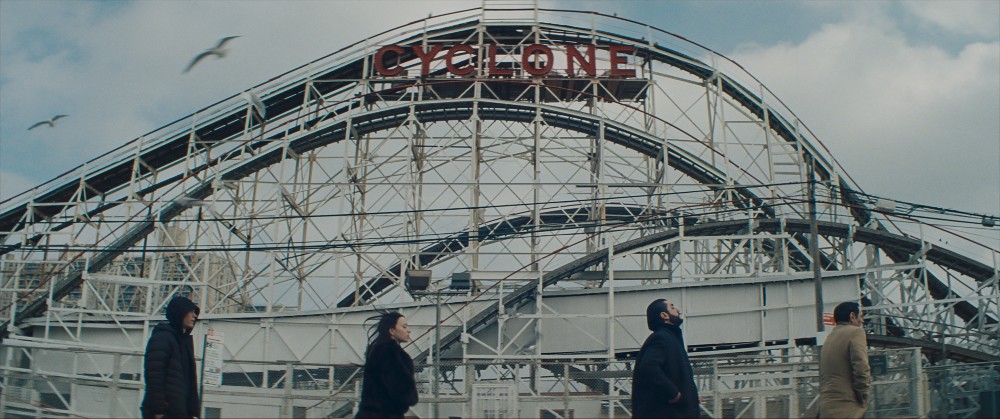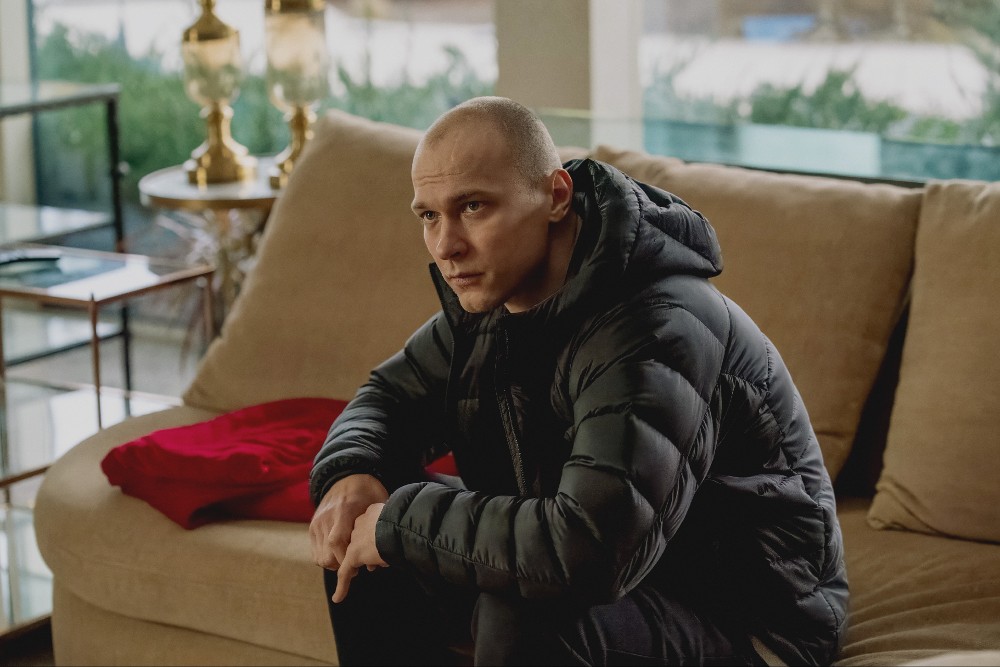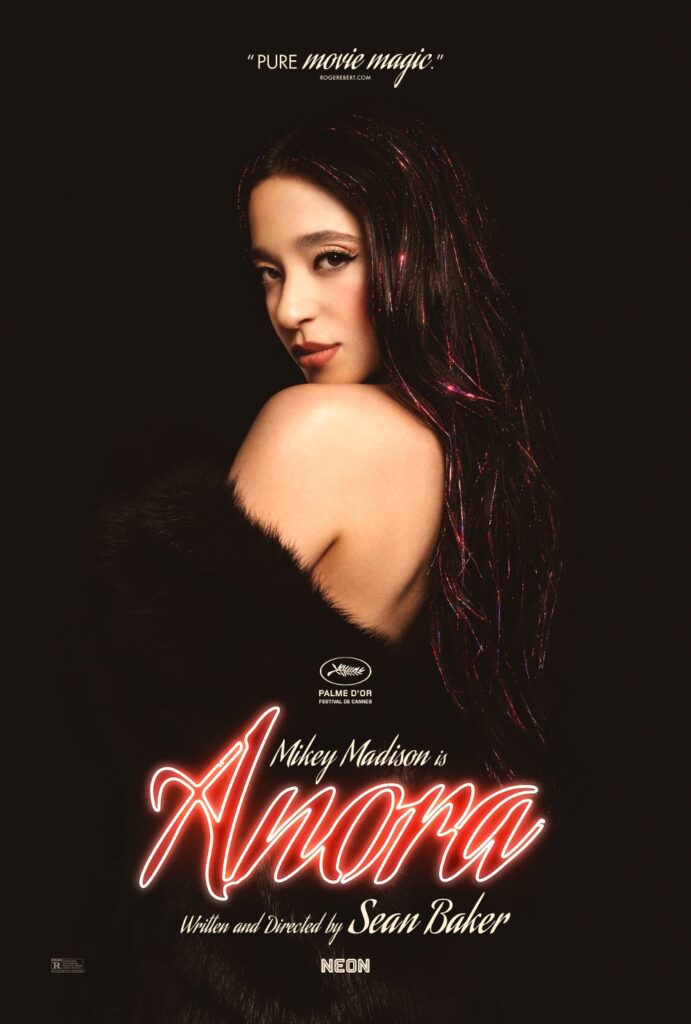
After years of making low-budget indie films, often with new or lesser-known talent, filmmaker Sean Baker is starting to get his due, thanks to the overwhelming success of his latest film, Anora, beginning with it winning the coveted Palme d’Or at this year’s Cannes Film Festival back in May.
Anora stars Mikey Madison from the 2022 Scream and Tarantino’s Once Upon a Time… in Hollywood as the title character, a Brooklyn erotic dancer and sex worker who is paired with Mark Eydelshteyn’s Vanya, the young son of a Russian oligarch, leading to the two running off to Las Vegas and getting married. Vanya’s rich parents are unhappy with that decision, and they send their goons to find the young couple and get the marriage annulled.
Ever since Baker’s new movie premiered at Cannes, it’s been receiving rave reviews, while playing at many of the big September festivals, including Telluride and the 62nd New York Film Festival. It opened in New York and Los Angeles last Friday, October 18, and it managed to rack up the highest per-theater average of the year in just six theaters. Distributor Neon will continue to expand the movie over the course of the next few weeks, and one can fully expect it to be the talk of this year’s Oscar race due to a combination of Ms. Madison’s performance and Baker’s distinctive writing and filmmaking, previously seen in films like The Florida Project and Red Rocket.
Cinema Daily US had a chance to speak with Baker for the print interview below, which has been edited for length and clarity, and he spoke to us about how Anora the movie came about, how he discovered Ms. Madison, and why he thinks that he will continue to make movies in this style, now that Anora has become so beloved.
Cinema Daily US: It must be nice for this movie to finally be coming to theaters. I know it’s done quite well in the festival circuit and people are loving it so far. I think I read that your own De Niro, Karren Karugulian, he was kind of an inspiration for writing this in some ways?
Sean Baker: My De Niro. [chuckles] Certainly, when he was younger, he resembled him. I guess he still does, but he’s been in every one of my films, as you know, and we’ve been trying to make this film for a while. We just didn’t know the plot. We wanted to tell a story in Brighton Beach and Coney Island, Brooklyn, because we felt that we could bring something new to that community, showing the community in a different way. He has connections, because he’s married to a Russian-American and had lots of stories. It was something that we had always talked about, and it was really after Red Rocket that it all came together when there was this other story I had heard about a young woman who was held as collateral by the Russian mob, because her deadbeat husband owed the mafia money. She started to realize through this incident that her husband was a deadbeat. She fell out of love with her husband because of this, and I found that fascinating.
I didn’t want to tell a Russian gangster story, though. I just felt it was overdone and had been done many times before. I was trying to figure out how I could still put this young sex worker in this situation. That’s when we came up with her marrying the son of a Russian oligarch. Boom. We got it. As soon as we had that, then it really started to roll. That was like the high-concept “eureka moment.”

CDUS: Was Toros always a character in your mind that you had thought for Karren to play?
Baker: Pretty early, I knew. He was the first cast, obviously. He’s not Russian, he’s Armenian, so I thought, “How can I work him in? Oh, I know. The babysitter of the son.” So yeah, he was the first cast, then came Yura [Borisov] actually, because I saw him in Compartment Number Six when I was at Cannes with Red Rocket and I know Juho Kuosmanen, the director, and I just said, “This guy’s incredible,” and he was like, “Yeah, he’s a star in Russia,” and I was like, “Oh, okay.” I then explored his filmography, so I knew there was this heavy, this character who was this Russian working for the Armenians, working for the Russians, like the lowest man on the totem pole. I knew it was gonna be Yura from the beginning, and then Mikey came. As soon as we had figured out that plot, and we were moving forward with the film, and I went to see Scream opening weekend, and that was that.
CDUS: I’d been hearing Mikey’s name mentioned a lot since Cannes. I hadn’t realized that I’d seen her in Scream and Once Upon a Time, though I hadn’t watched Better Things.
Baker: No, me neither. I’m not slamming series, but unfortunately, I just don’t have time to watch them – I stick to feature films – so I didn’t even know her stuff. She had such a strong impact on me from Once Upon a Time in Hollywood. I thought she stole the last 15 minutes of the movie. When she comes in that room with Brad Pitt, I was like, “Who’s this?” The way she just stands there in that stance, it’s haunting, and she really stuck with me. I said, “Someday, I’m gonna work with that actor,” and then Scream came about a few years later.
CDUS: It really struck me that this was your return to filming in New York for the first time since Prince of Broadway, since you’ve been setting your movies in other places since then. Knowing that you wanted to set it in Brighton Beach and that you’d shoot it there, what was involved with creating a movie that involves so many locations in that region?
Baker: That’s the thing about independent film. Normally, what happens is that you have a limited budget, so they say, “Okay it’s gonna be a two-header that takes place in an apartment,” and it’s two people talking. I push against that as much as possible. I think what brings production value is actually as many locations as possible. We always knew that we would be exploring that world, and there was so much to explore there. I always take a cue from Scorsese and Taxi Driver. I try to stay as geographically accurate as possible, even though for dramatic purposes, you sometimes have to break it. We just wanted to really show this route that they take, almost like … remember that that Family Circus cartoon, the little comic that was in newspapers? They would have the little dot-dot-dot path the kid would take home from school. That’s how I always saw it. The way they make their way to the boardwalk and down all the way to Brighton Beach and Tatiana’s and then back again. I wanted to stay accurate to that and really show the landmarks of Coney Island, because so much of it has stuck in time. That Cyclone [roller coaster] is over a hundred years old, and I just love the way that stuff looks on film. It was my way of almost taking postcard images of this wonderful location.

CDUS: And a lot of it is at night, also. For Tangerine and maybe even Prince of Broadway, you probably shot a lot of stuff just gun-and-run with a small camera. Can you still do that or is it harder to do that now?
Baker: It definitely is harder, and remember that I’m shooting on film and not an iPhone. When we go handheld, it’s [Cinematographer] Drew Daniels with a huge 35mm rig on his shoulder, and it’s not exactly inconspicuous. If a crew is down for the guerilla-style way of filmmaking, and everybody’s on board with that indie spirit, there are still ways of doing it. I had the best team, I had an incredible team, who came from other very low-budget DIY movies shot in the New York area, everything from Sean Price Williams’ Sweeties, and I think some of my team worked on some of the Safdie Brothers’ stuff like Good Time, so they understood it. We always tried to keep our footprint small. We have about a 40-person crew but when we’re shooting, it’s usually under 10 people, so no trailers, none of that. No big lighting. That was another thing that Drew was incredible at doing. I said, “Can we shoot New York at night without having big HMIs? How are we gonna do this?” We looked at the works of Owen Roizman, who shot The Taking of Pelham 1 2 3, he shot The French Connection. There was a lot of New York at night, or at least the subway in Taking of Pelham, where it’s dark. How can we shoot that on film? We used a lot of old techniques – we flashed the film. We sometimes pushed the negative by two stops. We shot on these vintage Lomo lenses, so we really did everything we could to make it look like it was not shot in 1974 with these faster stocks.
CDUS: This was Mark Eydelshteyn’s first English-language film, and maybe his first time working here. But I feel all of your movies have someone new in what ends up being a breakout role, like Brooklyn Prince in The Florida Project, Susanna in Red Rocket, or the cast of Tangerine. You always find people who are not that well known, at least here. What’s your drive to take that route with your casting?
Baker: It’s simply because I love to see fresh faces on the big screen, people who sometimes are presented for the first time to certain audiences. I mean, Mark is known over there, but this is his first exposure to Western audiences. I think it stems from Spike Lee – his films, they always had A-list talent perhaps as some of the leads, but he would always make sure he was bringing in new fresh faces, and he introduced so much talent to the world. I always saw it that way. When I see somebody whether it’s in another film, like Mikey, or whether it’s on the street like Susie Son – I saw her in the lobby of the Arclight [Cinema] –or sometimes it’s on Instagram, like Bria from Florida Project These are just people who strike me as they have the “it factor.” There’s something about them that demands that they are seen on the big screen. I want to see more of them. It’s a combination of their physicality and persona, they both have to be strong and intriguing.

CDUS: Your movie has been very well-received so far since Cannes, and I feel like you’re still using a similar style of filmmaking and storytelling, so does it feel like the rest of the world and the industry is finally catching up to what you do? It’s not like a drastic departure from what you’ve been doing.
Baker: I like this wheelhouse to a certain degree. These are plot-driven stories, if you really look at them. As I said earlier, sometimes it’s a high-concept: “Sex worker marries the son of a Russian oligarch.” I could just say that in a Hollywood pitch room, and that would be enough. At the same time, the way they have to be made in order for me to make it different from the way Hollywood would make it, is to have this guerilla indie way of filmmaking that forces limitations on you. When you have forced limitations, you have to think outside the box, and you have to figure out how to achieve the same thing but through a different way. That usually leads to serendipity and happy accidents. My two wonderful producers who I produce along with Alex Coco and Samantha Kwan, my wife, the three of us understand that we have about 90% controlled but 10% left up to the film gods. That means that sometimes it’s changing the schedule last minute or just stealing a shot here or there, or at the last minute, making a casting choice, pulling somebody from the location that we’re shooting at and putting them in a scene and seeing what happens. For example, Billy from the candy shop, he literally works at the candy shop. He’s so great, and he had so much color in real life. You know that he isn’t from central casting. That guy is from the real world. We were just there shooting, and we were like, “Billy, would you like to be in it? We can make you the boss.” That sort of stuff, and we always allow for that. I think that that’s the only way to really achieve this.
CDUS: You don’t see yourself renting out Pinewood for three months and building an entire world on the soundstages?Baker: No, no, no. [I’m] never shooting on sets. Sometimes, movies require it, and obviously, special effects films, they need it, but for me, I always want to shoot on location. You can’t get better than the real thing – production design is already halfway done for you And then, there’s also just the vibe. When you’re on set you’re shooting in the real world. I think the actors can feel it. Shooting in that mansion, that’s a real mansion It was designed by and lived in by a Russian oligarch up until Covid, and then, he sold it to a local Russian-American, but it just felt like we were in that world, and it really helps. It truly does.
Anora is now playing in New York and L.A. and will expand to more cities and eventually nationwide throughout November.
Check out more of CinemaDaily US’ video interviews on our YouTube channel
Screenwriter/Director: Sean Baker
Cast: Mikey Madison, Mark Eidelshtein, Karren Karagulian, Yura Borisov, Paul Weissman, Nazar Khamis, Luna Sofía Miranda
Producer: Sean Baker, Samanthan Quan, Alex Coco, Olivia Kavanaugh
Production Co: Cre FIlm, FilmNation Entertainment
Distributor: NEON
Rating: R (Strong Sexual Content Throughout|Graphic Nudity|Pervasive Language|Drug Use)
Genre: Comedy, Drama
Language: English, Russian, Armenian
Release Date (Theaters): October 18, 2024 (limited)
Runtime: 2 hours 19 minutes
If you like this video interview, please share your comments below.
Check out more of Edward Douglas’ articles.
You can watch the trailer below:


